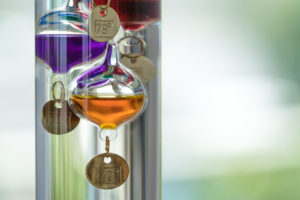 Have you seen those tubes of liquid, with glass balls of different sizes and colors floating in them? They’re mainly used as decoration, knickknacks placed on desks or coffee tables, but the device actually serves an important function. It’s called a Galileo thermometer, and while it’s a very old design, it can still be quite useful.
Have you seen those tubes of liquid, with glass balls of different sizes and colors floating in them? They’re mainly used as decoration, knickknacks placed on desks or coffee tables, but the device actually serves an important function. It’s called a Galileo thermometer, and while it’s a very old design, it can still be quite useful.
History of Galileo Thermometers
Despite its name, the Galileo thermometer wasn’t actually invented by Galileo. It was first described in 1666 in a paper written by several scientists and engineers, including Torricelli, Galileo’s student. It featured multiple glass spheres of different weights, suspended in a solution of ethanol, and was called a “slow thermometer.”
Over time, as other, more precise thermometers were developed, the thermometer fell into disuse. Until the early 1990s, when the Natural History Museum in London started selling them as souvenirs. They gradually gained popularity and can now be seen all over.
How Galileo Thermometers Work
The underlying principle of the Galileo thermometer is that a liquid’s density changes as its temperature changes. A tube is filled with liquid such as ethanol. Several glass spheres, also filled with liquid, dyed different colors, are also placed in the tube.
Each sphere represents a different temperature increment: 60 degrees, 65, 70, etc. The lower temperature spheres are heavier, and the higher temperature spheres lighter. When the temperature is 70 degrees, the 70-degree sphere (and all higher temperature spheres) will be less dense than the liquid, causing them to float. If the temperature drops to 65, the liquid becomes denser, so the heavier 65-degree sphere can float as well, just below the others. If it rises to 75, the liquid becomes less dense, and the 70-degree weight will sink.
It makes a great decoration for your home, and is a great way to tell the temperature at a glance, but if you’re looking for accurate measurement to heat or cool your home by, stick to your thermostat.
To learn more about thermometers and other HVAC issues, contact us at Hansberger Refrigeration and Electric Company. We’re Yuma’s trusted source for heating and cooling solutions.
Our goal is to help educate our customers in Yuma, Arizona about energy and home comfort issues (specific to HVAC systems). For more information about other HVAC topics, download our free Home Comfort Guide or call us at 928-723-3183.

